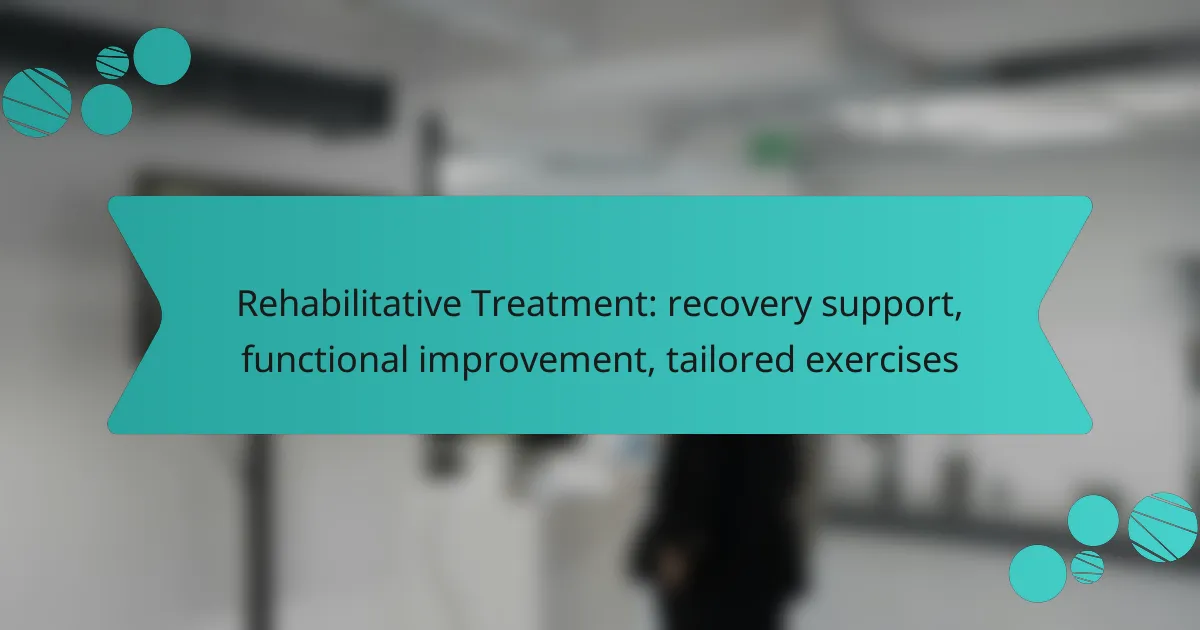Rehabilitative treatment plays a crucial role in supporting recovery and enhancing functional improvement for individuals recovering from injuries or illnesses. By offering tailored exercises and therapies, such as physical and occupational therapy, these treatments are designed to meet specific needs, promoting overall well-being and restoring functionality.

What rehabilitative treatments are available in Canada?
In Canada, a variety of rehabilitative treatments are available to support recovery and functional improvement. These treatments are tailored to individual needs and may include physical therapy, occupational therapy, speech therapy, chiropractic care, and massage therapy.
Physical therapy
Physical therapy focuses on improving movement and function through targeted exercises and manual therapy. It is commonly used for recovery from injuries, surgeries, or chronic pain conditions. A physical therapist will assess your condition and develop a personalized exercise program to enhance strength, flexibility, and mobility.
In Canada, sessions typically last between 30 to 60 minutes, and patients may require multiple visits per week depending on their recovery goals. It’s essential to follow the therapist’s guidance to avoid setbacks.
Occupational therapy
Occupational therapy helps individuals regain the skills needed for daily activities and work. This may involve adapting tasks or environments to improve independence and quality of life. An occupational therapist will evaluate your needs and create a customized plan that may include exercises, assistive devices, and strategies to overcome challenges.
In Canada, occupational therapy can be particularly beneficial for those recovering from strokes, injuries, or surgeries, as it focuses on practical skills and functional improvement.
Speech therapy
Speech therapy addresses communication and swallowing disorders, often following neurological events like strokes or traumatic brain injuries. A speech-language pathologist will assess your abilities and provide exercises to improve speech clarity, language comprehension, and swallowing safety.
In Canada, therapy sessions can vary in length and frequency, depending on individual needs. Early intervention is crucial for optimal recovery, so seeking help promptly is advisable.
Chiropractic care
Chiropractic care focuses on diagnosing and treating musculoskeletal disorders, particularly those related to the spine. Chiropractors use hands-on spinal manipulation and other techniques to alleviate pain and improve function. This treatment can be effective for back pain, neck pain, and headaches.
In Canada, chiropractic sessions typically last around 30 minutes, and the number of visits needed can vary based on the severity of the condition. It’s important to choose a licensed chiropractor to ensure safe and effective care.
Massage therapy
Massage therapy involves manipulating soft tissues to relieve tension, reduce pain, and promote relaxation. It can be beneficial for various conditions, including muscle strains, stress, and chronic pain. A registered massage therapist will tailor the treatment to your specific needs and preferences.
In Canada, massage therapy sessions usually last between 60 to 90 minutes, and regular sessions can enhance recovery and overall well-being. Always communicate your comfort levels and any medical conditions to your therapist for the best results.

How do rehabilitative treatments support recovery?
Rehabilitative treatments are designed to assist individuals in recovering from injuries or illnesses by promoting functional improvement and overall well-being. These treatments often include tailored exercises that address specific needs, enhancing the recovery process.
Enhance mobility
Rehabilitative treatments improve mobility by focusing on exercises that increase range of motion and flexibility. Techniques such as stretching, balance training, and gait training are commonly employed to help patients regain their ability to move freely.
For effective mobility enhancement, consider incorporating activities like walking, cycling, or swimming into your routine. These low-impact exercises can be adjusted to match individual capabilities, making them suitable for various fitness levels.
Reduce pain
Rehabilitative treatments can significantly reduce pain through targeted therapies and exercises that promote healing. Techniques such as physical therapy, massage, and heat or cold therapy help alleviate discomfort and improve function.
Patients are encouraged to communicate openly about their pain levels to tailor treatment plans effectively. Utilizing methods like gentle stretching or low-impact aerobic exercises can also help manage pain while promoting recovery.
Improve strength
Strength improvement is a key focus of rehabilitative treatments, as it helps individuals regain independence and perform daily activities. Resistance training, bodyweight exercises, and functional movements are commonly used to build muscle strength.
To enhance strength effectively, start with lighter weights or resistance bands and gradually increase intensity as your capabilities improve. Consistency is crucial, so aim for regular sessions several times a week to see noticeable progress.
Boost mental health
Engaging in rehabilitative treatments can have a positive impact on mental health by reducing feelings of anxiety and depression. Physical activity releases endorphins, which can enhance mood and promote a sense of well-being.
Incorporating social elements, such as group therapy or exercise classes, can further support mental health by fostering connections with others. Mindfulness practices, such as yoga or meditation, can also complement physical rehabilitation efforts, providing a holistic approach to recovery.

What tailored exercises are effective for functional improvement?
Effective tailored exercises for functional improvement focus on enhancing strength, balance, flexibility, and endurance. These exercises are designed to meet individual needs, helping to restore functionality and support recovery.
Strength training
Strength training involves exercises that improve muscle strength and endurance, which are crucial for daily activities. Common methods include using free weights, resistance bands, or bodyweight exercises like squats and push-ups.
When starting a strength training program, aim for two to three sessions per week, focusing on major muscle groups. Gradually increase the weight or resistance as strength improves, but ensure proper form to prevent injury.
Balance exercises
Balance exercises enhance stability and coordination, reducing the risk of falls. Simple activities like standing on one leg, heel-to-toe walking, or using a balance board can be effective.
Incorporate balance training into your routine two to three times a week. Start with basic exercises and progress to more challenging ones as confidence and stability improve.
Flexibility routines
Flexibility routines involve stretching exercises that improve the range of motion in joints and muscles. Incorporating stretches for major muscle groups can help alleviate stiffness and enhance mobility.
Perform flexibility exercises at least three times a week, holding each stretch for 15 to 30 seconds. Focus on areas that feel tight, and avoid bouncing during stretches to prevent injury.
Endurance activities
Endurance activities, such as walking, cycling, or swimming, improve cardiovascular fitness and overall stamina. These exercises can be tailored to individual fitness levels and preferences.
Engage in endurance activities for at least 150 minutes per week, spread across several days. Start with moderate intensity and gradually increase duration and intensity as fitness improves.

How to choose the right rehabilitative treatment?
Selecting the appropriate rehabilitative treatment involves understanding individual needs, consulting healthcare professionals, and evaluating available options. Tailored exercises and support systems play a crucial role in recovery and functional improvement.
Assess individual needs
Begin by identifying specific recovery goals, such as regaining mobility, strength, or daily living skills. Consider factors like age, physical condition, and any pre-existing health issues that may affect rehabilitation.
It can be helpful to create a list of personal challenges and desired outcomes. For example, someone recovering from a knee injury may prioritize walking without pain, while another may focus on returning to sports.
Consult healthcare professionals
Engaging with healthcare professionals, such as physical therapists or rehabilitation specialists, is essential for personalized treatment. They can conduct assessments to determine the best course of action based on individual needs.
Ask questions about their experience, treatment philosophies, and success stories. This can help build trust and ensure that the chosen professional aligns with your recovery goals.
Evaluate treatment options
Explore various rehabilitative treatments, including physical therapy, occupational therapy, and specialized exercise programs. Each option may offer different techniques and approaches to support recovery.
Consider factors such as duration, frequency, and cost of treatments. For instance, some programs may require multiple sessions per week over several months, while others might be more flexible. Weigh the pros and cons of each option to find the best fit for your situation.

What are the costs of rehabilitative treatments in Canada?
The costs of rehabilitative treatments in Canada can vary significantly based on the type of therapy, location, and duration of treatment. On average, individuals may expect to pay anywhere from CAD 50 to CAD 200 per session, depending on the service provider and specific needs.
Factors Influencing Costs
Several factors influence the costs of rehabilitative treatments, including the type of therapy required, the provider’s experience, and geographical location. For instance, urban centers may have higher rates compared to rural areas due to demand and operational costs.
Insurance coverage can also play a crucial role. Many Canadians have health insurance plans that cover part of the costs, which can significantly reduce out-of-pocket expenses. It’s advisable to check with your insurance provider to understand what is included.
Types of Rehabilitative Treatments
Rehabilitative treatments encompass a variety of services, including physical therapy, occupational therapy, and speech therapy. Each type serves different needs; for example, physical therapy focuses on improving movement and function, while occupational therapy helps individuals regain skills for daily living.
Costs can differ based on the complexity of the treatment. For example, specialized therapies may cost more due to the expertise required. It’s essential to assess your specific needs and seek providers who can offer tailored solutions.
Average Costs of Common Treatments
Common rehabilitative treatments in Canada have varying average costs. For instance, physical therapy sessions typically range from CAD 80 to CAD 150, while occupational therapy may cost between CAD 100 and CAD 180 per session. Speech therapy can range from CAD 90 to CAD 160.
Understanding these averages can help you budget effectively. It’s also useful to inquire about package deals or multi-session discounts, which some clinics offer to reduce overall expenses.
Financial Assistance and Coverage Options
Many Canadians can access financial assistance for rehabilitative treatments through provincial health plans or private insurance. Some provinces may cover specific therapies under their healthcare system, while others may require private insurance for full coverage.
Additionally, certain non-profit organizations provide financial support or resources for individuals needing rehabilitation services. Researching these options can help alleviate some financial burdens associated with treatment.
